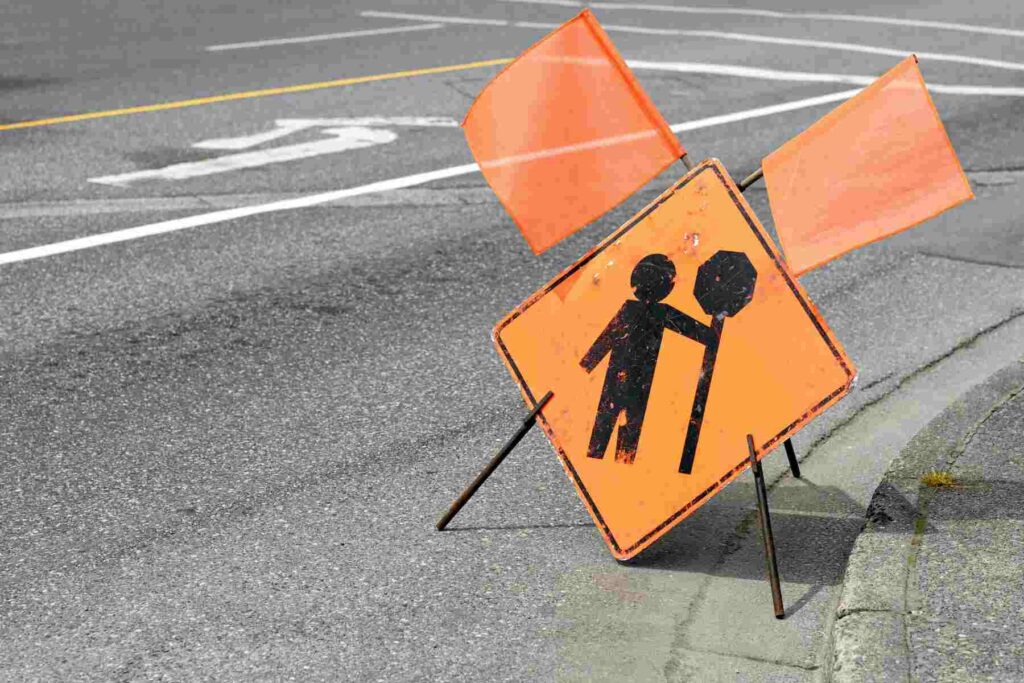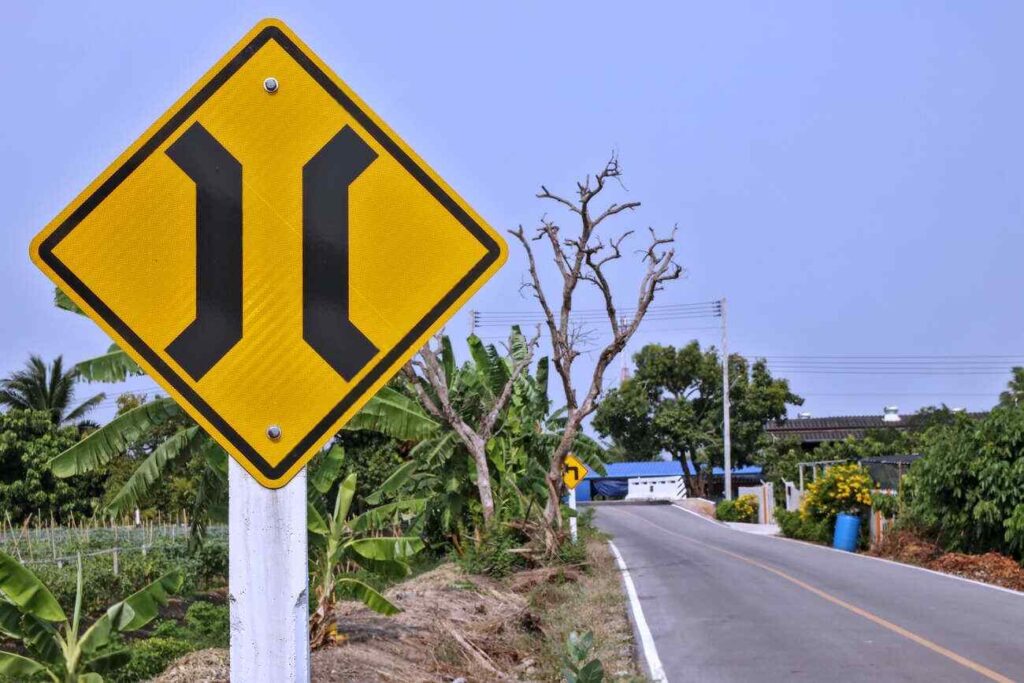Have you ever driven through a work zone and seen a bright orange sign with a figure holding a flag? That’s the flagger ahead sign. It warns you that a person is directing traffic just up the road. This sign plays a key role in keeping roads safe during repairs or builds.
In this post, we’ll cover the flagger ahead meaning, why it’s there, and what to do when you spot it. We’ll also touch on the flagger ahead sign explained in detail and why the flagger ahead sign is important. Plus, we’ll look at related warnings like the steep hill ahead sign and road sign for steep ascent. By the end, you’ll know how to handle these signs with ease.
Road work happens all the time. From fixing potholes to building bridges, crews need space to work. Signs like this one help manage traffic flow. They reduce risks for everyone on the road. Let’s start with the basics of what this sign looks like and stands for.
What Is the Flagger Ahead Sign?
The flagger ahead sign is a common sight in work zones. It’s diamond-shaped with an orange background and black symbols. The main image shows a person standing with a flag or paddle raised. Sometimes words like “FLAGGER AHEAD” appear below the figure. This design comes from the Manual on Uniform Traffic Control Devices, or MUTCD, which sets rules for signs in the US.
The sign’s code is W20-7 in the MUTCD. It’s part of the warning group for temporary traffic control. Orange color means caution—work area ahead. The diamond shape grabs attention fast. Signs like this are placed 500 to 1,000 feet before the flagger, based on speed limits. On fast highways, you might see it farther back.
Flaggers are trained workers who direct cars through zones. They use paddles with “STOP” on one side and “SLOW” on the other. The sign prepares you for their signals. Without it, drivers might speed through and cause harm.
These signs are made from tough materials like aluminum. They reflect light for night use. In bad weather, crews add lights or flags to make them stand out more. If you’re in a truck or RV, pay close heed—these zones can have narrow lanes.
New drivers might not know this sign right away. But once you see it a few times, it becomes clear. It’s not just for show; it’s a tool to save lives.
Flagger Ahead Meaning: Breaking It Down
The flagger ahead meaning is straightforward. It tells you a human is controlling traffic soon. This happens in spots where machines or lights can’t do the job. Think one-lane bridges or lane closures. The flagger stops one side while the other goes.
In simple terms, the sign says: Slow down, watch for directions, and be ready to stop. Ignoring it can lead to fines or crashes. The MUTCD requires this sign in most flagging setups. It’s often paired with other warnings like “ROAD WORK AHEAD.”
The flagger ahead meaning also ties to safety rules. States like California have handbooks that explain when to use it. For example, in rural areas with low traffic, flaggers handle flow better than signals.
At night, the meaning stays the same, but flaggers wear bright vests and use lit paddles. The sign might have extra reflectors. Rain or fog makes it even more critical—wet roads mean longer stops.
For bikers or walkers, the flagger ahead meaning includes waiting your turn. Flaggers direct all users, not just cars.
In short, this sign means prepare for guided traffic. It keeps order in chaotic spots.
Flagger Ahead Sign Explained: How It Works
Let’s get into the flagger ahead sign explained step by step. First, spot the sign early. It’s orange and diamond-shaped, so it stands out. As you approach, reduce speed. Look for the flagger station ahead.
The flagger stands in a safe spot, often on the shoulder. They hold a paddle or flag. When it shows “STOP,” halt fully. Wait until “SLOW” or a wave lets you go.
In two-way setups, two flaggers coordinate. One stops while the other releases. Pilot cars might lead groups through long zones.
The flagger ahead sign explained also covers setup. Crews place advance signs like “BE PREPARED TO STOP.” Cones or barriers guide lanes.
If no flagger appears, proceed with care. Sometimes shifts end, but signs stay up. Report missing workers to local DOT.
For drivers, stay patient. Delays happen, but safety comes first.
Why the Flagger Ahead Sign Is Important
The flagger ahead sign is important for many reasons. First, it protects workers. Construction zones see thousands of crashes yearly. Signs like this cut those numbers.
It also shields drivers. Sudden stops without warning lead to rear-ends. The sign gives time to react.
In terms of law, the flagger ahead sign is important because ignoring flaggers can mean tickets. Fines range from $100 to $500, plus points on your license.
For businesses, it’s key to smooth ops. Good traffic control means less downtime for crews.
On a bigger scale, these signs support economy. Road fixes keep commerce moving. Without safe zones, projects drag on.
In bad weather, the flagger ahead sign is important for visibility. It warns of slippery spots or debris.
Overall, this sign saves time, money, and lives.
How to Respond to the Flagger Ahead Sign
When you see the flagger ahead sign, act right away. Drop your speed by 10-20 mph. Turn off music and focus.
As you near, watch the flagger’s paddle. “STOP” means full halt—no creeping. Keep distance from the car ahead.
When released, go slow through the zone. Speed limits often drop to 25 mph.
If in a line, don’t pass. Stay in order.
For night drives, use low beams near workers.
Parents, teach kids to spot these signs. It builds good habits.
Truckers: Downshift early. Heavy loads need more stop time.
Bikers: Signal clearly and wear bright gear.
These steps make zones safer for all.
Safety Tips for Flagger Ahead Zones
Safety tips start with prep. Check apps for work zones before trips.
In the zone, no phone use. Distractions kill.
Wear seatbelts always.
If you’re a flagger, stand visible but safe. Have an escape path.
Crews: Use proper signs spaced right.
Report bad setups to authorities.
These tips prevent mishaps.
A Look at the History of the Flagger Ahead Sign
The history of the flagger ahead sign goes back to the 1920s. Early roads had few controls. As cars grew, so did needs for signs.
In 1935, the first MUTCD set basics. Warning signs for work zones came soon after.
By the 1960s, orange became standard for temp signs.
The flagger symbol changed in 2002 to a universal figure.
Today, updates focus on night use and tech.
This evolution shows growing safety focus.
Variations of the Flagger Ahead Sign by State and Abroad
In the US, the flagger ahead sign is mostly uniform. But states add twists. Ohio uses it with temp signals sometimes.
Texas has its own MUTCD version with similar designs.
Abroad, signs differ. In the UK, it’s a triangle with a worker figure.
Canada matches the US closely.
Australia uses yellow with text like “FLAGMAN AHEAD.”
Travelers, learn local signs via apps.
These variations keep the core message: Caution ahead.
Related Signs: Steep Hill Ahead Sign and Road Sign for Steep Ascent
The flagger ahead sign often pairs with others. The steep hill ahead sign warns of sharp drops. It’s yellow diamond with a truck on a slope. Code W7-1.
Use low gear going down to control speed.
The road sign for steep ascent shows an uphill slope. W7-2 or similar. Shift down before climbing.
In work zones, these might appear with flaggers if hills add risk.
Other relates: “ONE LANE ROAD” or “MERGE LEFT.”
Knowing them all helps read roads better.
Common Mistakes with Flagger Ahead Signs
Drivers often speed past the sign. This leaves no time to stop.
Another: Ignoring the flagger. Always follow signals.
Flaggers err by poor positioning. Stay out of lanes.
Crews forget to remove signs after work. This confuses traffic.
Avoid by double-checks.
Real-Life Stories from Flagger Zones
A driver in Texas ignored a flagger—crashed into barriers. Fine and lesson learned.
A flagger in California dodged a speeding car. Signs saved the day.
Share your tales below.
Teaching Kids About the Flagger Ahead Sign
Point out signs on drives. Explain the flagger ahead meaning.
Make games: Who spots it first?
Tie to safety rules at home.
Grows aware kids.
Maintenance of Flagger Ahead Signs
Clean signs regularly. Dirt hides them.
Replace damaged ones fast.
Crews check daily.
Keeps them effective.
For more information visit Traffic signs test.
Wrapping Up: Stay Safe with the Flagger Ahead Sign
The flagger ahead sign keeps roads orderly during work. Understand the flagger ahead meaning, follow when the flagger ahead sign is explained, and see why the flagger ahead sign is important. Pair it with knowledge of the steep hill ahead sign and road sign for steep ascent for full prep.


